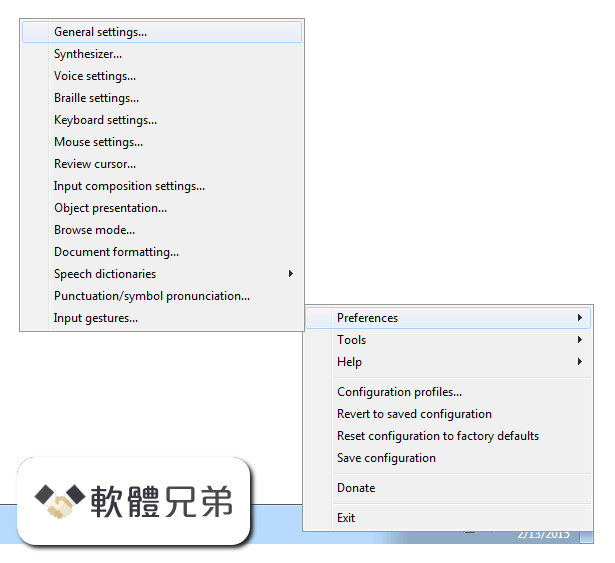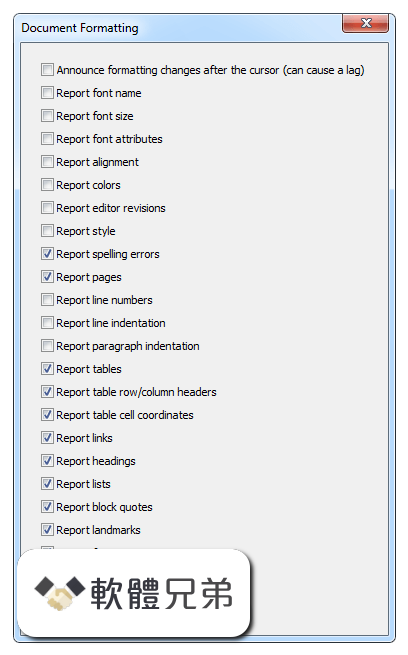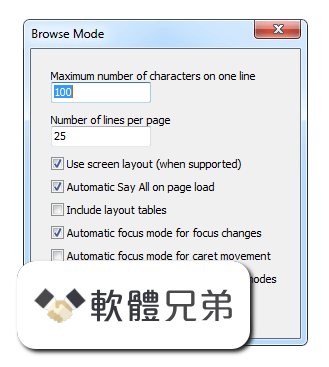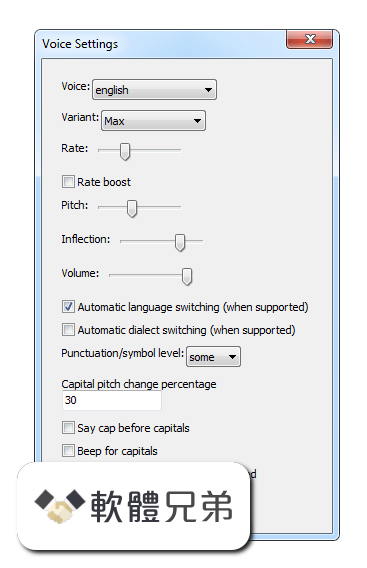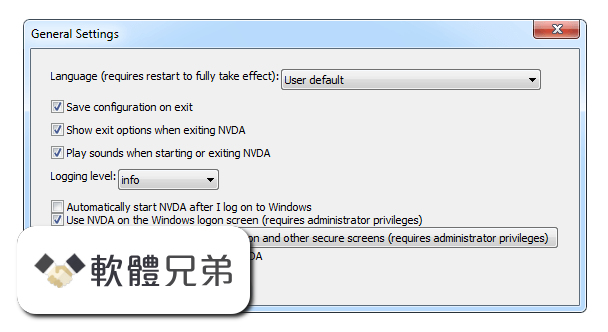|
What's new in this version: New Features:
- NVDA no longer fails to start on a system with no audio output devices. Obviously, a braille display or the Silence synthesiser in conjunction with the Speech Viewer will need to be used for output in this case. (#425)
- A report landmarks checkbox has been added to the Document Formatting settings dialog which allows you to configure whether NVDA should announce landmarks in web documents. For compatibility with the previous release, the option is on by default.
- If speak command keys is enabled, NVDA will now announce the names of multimedia keys (e.g. play, stop, home page, etc.) on many keyboards when they are pressed. (#472)
- NVDA now announces the word being deleted when pressing control+backspace in controls that support it. (#491)
- Arrow keys can now be used in the Web formator window to navigate and read the text. (#452)
- The entry list in the Microsoft Office Outlook address book is now supported.
- NVDA better supports embedded editable (design mode) documents in Internet Explorer. (#402)
- a new script (nvda+shift+numpadMinus) allows you to move the system focus to the current navigator object.
- New scripts to lock and unlock the left and right mouse buttons. Useful for performing drag and drop operations. shift+numpadDivide to lock/unlock the left, shift+numpadMultiply to lock/unlock the right.
- New braille translation tables: German 8 dot computer braille, German grade 2, Finnish 8 dot computer braille, Chinese (Hong Kong, Cantonese), Chinese (Taiwan, Manderin). (#344, #369, #415, #450)
- It is now possible to disable the creation of the desktop shortcut (and thus the shortcut key) when installing NVDA. (#518)
- NVDA can now use IAccessible2 when present in 64 bit applications. (#479)
- Improved support for live regions in Mozilla applications. (#246)
- The NVDA Controller Client API is now provided to allow applications to control NVDA; e.g. to speak text, silence speech, display a message in Braille, etc.
- Information and error messages are now read in the logon screen in Windows Vista and Windows 7. (#506)
- In Adobe Reader, PDF interactive forms developed with Adobe LiveCycle are now supported. (#475)
- In Miranda IM, NVDA now automatically reads incoming messages in chat windows if reporting of dynamic content changes is enabled. Also, commands have been added to report the three most recent messages (NVDA+control+number). (#546)
- Input text fields are now supported in Adobe Flash content. (#461)
Changes:
- The extremely verbose keyboard help message in the Windows 7 Start menu is no longer reported.
- The Display synth has now been replaced with a new Speech Viewer. To activate it, choose Speech Viewer from the Tools menu. The speech viewer can be used independently of what ever speech synthesizer you are using. (#44)
- Messages on the braille display will automatically be dismissed if the user presses a key that results in a change such as the focus moving. Previously the message would always stay around for its configured time.
- Setting whether braille should be tethered to the focus or the review cursor (NVDA+control+t) can now be also set from the braille settings dialog, and is also now saved in the user's configuration.
- Updated eSpeak speech synthesiser to 1.43.03.
- Updated liblouis braille translator to 1.8.0.
- In virtual buffers, the reporting of elements when moving by character or word has been greatly improved. Previously, a lot of irrelevant information was reported and the reporting was very different to that when moving by line. (#490)
- The Control key now simply stops speech like other keys, rather than pausing speech. To pause/resume speech, use the shift key.
- Table row and column counts are no longer announced when reporting focus changes, as this announcement is rather verbose and usually not useful.
Bug Fixes:
- NVDA no longer fails to start if UI Automation support appears to be available but fails to initialise for some reason. (#483)
- The entire contents of a table row is no longer sometimes reported when moving focus inside a cell in Mozilla applications. (#482)
- NVDA no longer lags for a long time when expanding tree view items that contain a very large amount of sub-items.
- When listing SAPI 5 voices, NVDA now tries to detect buggy voices and excludes them from the Voice Settings dialog and synthesiser settings ring. Previously, when there was just one problematic voice, NVDA's SAPI 5 driver would sometimes fail to start.
- Virtual buffers now honour the report object shortcut keys setting found in the Object Presentation dialog. (#486)
- In virtual buffers, row/column coordinates are no longer incorrectly read for row and column headers when reporting of tables is disabled.
- In virtual buffers, row/column coordinates are now correctly read when you leave a table and then re-enter the same table cell without visiting another cell first; e.g. pressing upArrow then downArrow on the first cell of a table. (#378)
- Blank lines in Microsoft Word documents and Microsoft HTML edit controls are now shown appropriately on braille displays. Previously NVDA was displaying the current sentence on the display, not the current line for these situations. (#420)
- Multiple security fixes when running NVDA at Windows logon and on other secure desktops. (#515)
- The cursor position (caret) is now correctly updated when performing a Say All that goes off the bottom of the screen, in standard Windows edit fields and Microsoft Word documents. (#418)
- In virtual buffers, text is no longer incorrectly included for images inside links and clickables that are marked as being irrelevant to screen readers. (#423)
- Fixes to the laptop keyboard layout. (#517)
- When Braille is tethered to review when you focus on a Dos console window, the review cursor can now properly navigate the text in the console.
- While working with TeamTalk3 or TeamTalk4 Classic, the VU meter progress bar in the main window is no longer announced as it updates. Also, special characters can be read properly in the incoming chat window.
- Items are no longer spoken twice in the Windows 7 Start Menu. (#474)
- Activating same-page links in Firefox 3.6 appropriately moves the cursor in the virtualBuffer to the correct place on the page.
- Fixed the issue where some text was not rendered in Adobe Reader in certain PDF documents.
- NVDA no longer incorrectly speaks certain numbers separated by a dash; e.g. 500-1000. (#547)
- In Windows XP, NVDA no longer causes Internet Explorer to freeze when toggling checkboxes in Windows Update. (#477)
- When using the in-built eSpeak synthesiser, simultaneous speech and beeps no longer intermittently cause freezes on some systems. This was most noticeable, for example, when copying large amounts of data in Windows Explorer.
- NVDA no longer announces that a Firefox document has become busy (e.g. due to an update or refresh) when that document is in the background. This also caused the status bar of the foreground application to be spuriously announced.
- When switching Windows keyboard layouts (with control+shift or alt+shift), the full name of the layout is reported in both speech and braille. Previously it was only reported in speech, and alternative layouts (e.g. Dvorak) were not reported at all.
- If reporting of tables is disabled, table information is no longer announced when the focus changes.
- Certain standard tree view controls in 64 bit applications (e.g. the Contents tree view in Microsoft HTML Help) are now accessible. (#473)
- Fixed some problems with logging of messages containing non-ASCII characters. This could cause spurious errors in some cases on non-English systems. (#581)
- The information in the About NVDA dialog now appears in the user's configured language instead of always appearing in English. (#586)
- Problems are no longer encountered when using the synthesiser settings ring after the voice is changed to one which has less settings than the previous voice.
- In Skype 4.2, contact names are no longer spoken twice in the contact list.
- Fixed some potentially major memory leaks in the GUI and in virtual buffers. (#590, #591)
- Work around a nasty bug in some SAPI 4 synthesisers which was causing frequent errors and crashes in NVDA. (#597)
NVDA 2010.1 相關參考資料
2010.1 Milestone
NVDA, the free and open source Screen Reader for Microsoft Windows - 2010.1 Milestone · nvaccess/nvda.
https://github.com
blank lines add on.
Hello. Does anyone know if there is an addon where you can turn off the feature where if NVDA says blank if there is a blank line or a carriage return it ...
https://nvda.groups.io
Downloading NVDA 2010.1 from FileHorse.com
NVDA (NonVisual Desktop Access) is a free “screen reader” which enables blind and vision-impaired people to use computers. It reads the text on the screen ...
https://www.filehorse.com
GeForceION Release 196 - 下載驅動程式 - NVIDIA
版本: 196.21 ; 發佈日期: 2010.1.19 ; 作業系統: Windows 7 64-bit, Windows Vista 64-bit ; CUDA Toolkit: 語言: ; 語言: Chinese (Traditional).
https://www.nvidia.com.tw
GeForceION Release 196 | 196.21 - NVIDIA
Version: 196.21 ; Release Date: 2010.1.19 ; Operating System: Windows 7 32-bit, Windows Vista 32-bit ; CUDA Toolkit: Language: ; Language: Chinese (Traditional).
https://www.nvidia.com.tw
Index of filesnvdareleases2010.1
Index of /files/nvda/releases/2010.1/ ../ nvda_2010.1_changes.txt 11-Feb-2015 07:50 57208.
https://www.nvaccess.org
NonVisual Desktop Access - Browse releases at ...
Free, open source screen reader for Windows.
https://sourceforge.net
NVDA Portable 2010.1 Development Test 2
This software can enable blind or vision impaired people to access computers running Windows, for no more cost than a sighted person. NVDA ...
https://portableapps.com
Slides and Notes for - EASI
NVDA 2010.1 Highlights. Why use NVDA? Why NVDA? - The Cost Factor. Why NVDA? - Public Access. Why NVDA? - Supporting Others. Why NVDA? - Testing Products. Why ...
http://easi.cc
|
